Was Bolivia-Peru the Sunset Land of the Sumerians?
In an article on the Fuente Magna Bowl, April Holloway highlighted the evidence of Sumerian writing in South America. The Fuente Magna Bowl and Pokotia monument indicate that Sumerians may have formerly lived in South America.
The possibility that the writing on the Fuente Magna Bowl was used by the Sumerians, and the identification of Sumerian placenames on the Altiplano suggest that Bolivia and Peru may represent the "Tin Land of the West" or the "Sunset Land", of Sumerian inscriptions.

A figure on the Fuente Magna bowl. (Courtesy of Bernardo Biados’s research team)

The Fuente Magna Bowl was found to have two types of scripts engraved on the inside. (Courtesy of Bernardo Biados’s research team)
Kuga-ki
The Sumerians mention a land in the West called Kuga-ki where they mined valuable metals. Dr. A.H. Sayce said that Tin-land in Sumerian was KUGA-KI. Sayce made it clear that Sumerians claimed that they obtained tin from this land.
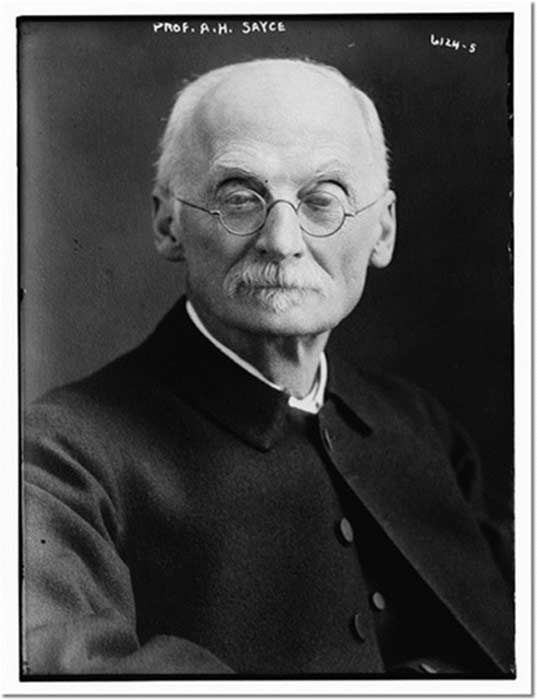
Prof. A.H. Sayce
The ancient Sumerians were great navigators. Sumerian Ships sailed to Egypt, Northeast Africa, and the Indus Valley in search of metals and goods to support their industry and popular demands for goods by the people. Samuel N. Kramer in The Sumerians, said that Egypt in the Sumerian inscriptions was Magan, and the Indus Valley was called Dilmun.
- The Legacy of Armenia: Trade, Metallurgy, and Forging of Precious Metals of the Ancient World
- Fuente Magna, the Controversial Rosetta Stone of the Americas
- Mountains of Silver: Tiny Bolivian village of Potosi was once the largest industrial mining complex in the world
King Sargon in 2700 BC mentions that Kuga-Ki was part of his Empire. Prof. Sayce, in a paper named “Geography of Sargon of Akkad”, published in the journal Ancient Egypt , translated a document written by a 8th Century B.C., Assyrian official . The document stated that Sargon I , Empire included "the countries from the rising to the setting of the sun, which Sargon the . . . king conquered with his hand," included amongst many other lands "the Land of Gutium," "the land of the Muru (or Amorites)" and (Kuga-Ki) "the Tin-land country which lies beyond the Upper Sea (or Mediterranean)."
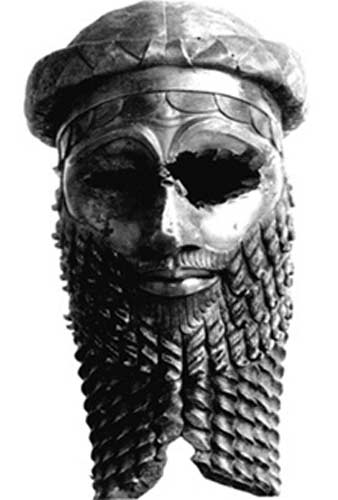
Bronze head of a king, most likely Sargon of Akkad. (Public Domain)
Sayce believed that Kuga-Ki was probably located in Spain. The presence of the Fuente Magna Bowl suggests that Kuga-Ki was in South America instead of Spain. Since Kuga-Ki was west of the Mediterranean it was probably the name for some region in North or South America, because the Americas lie west of the Meditteranean Sea, while Spain lies on the Meditterranean.
A.H Verrill and R. Verrill, in Americas Ancient Civilizations, and J. Bailey in Sailing to Paradise, maintain that the area around Lake Titicaca may have been called Lake Manu by the Sumerians. According to the Verrills and Bailey, traditions claim that Sumerians made many visits to the land west of the Mediterranean, which they called the Kuga-ki. The traditions make it clear that Sumerians sailed to Kuga-ki in their Magur ships. Cuneiform tablets make it clear the Magur ships could carry 18.5 metric tons of precious metals.
Mining Operations
The Sumerians probably first made contact with Kuga-kivia, the Atlantic currents that take you from Africa to Brazil. Prospectors probably reached Brazil, and sailed down the Amazon river until they found large tin deposits in Bolivia-Peru. The major center for mining in Bolivia-Peru is and was Potosi.
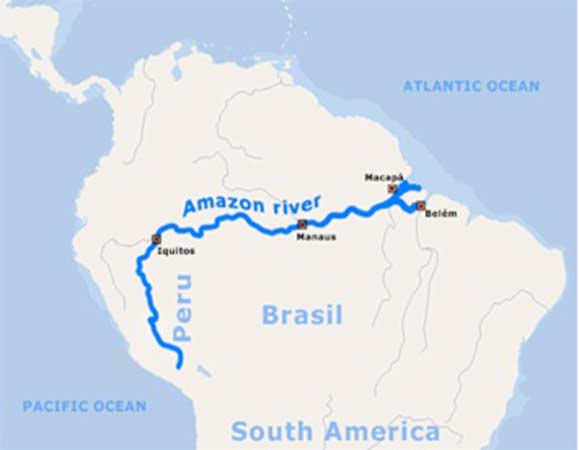
Map of the Amazon River (Source)
Once they established mining operations in Kuga-ki, local people probably began to work in the mining operations and adopted many Sumerian customs, linguistic terms and the social technology of writing, i.e., the Proto-Sumerian script. This means that writing has a long tradition among the people of Bolivia-Peru as Clyde Winters writes in Ancient Scripts in South America.
Kingdom of the Antis
The Andes may have been the Tin land or Kuga-Ki of the Sumerians. The Andes mountains were originally called Antis. This area was formerly called Antisuyo, Kingdom of the Antis. This was also the homeland of the Antis Indians. In the Quechua language spoken by many Indians in the area, antis means copper. Antis was also the name for the native peoples who formerly lived in this part of South America.
Antis is probably of non-Quechua origin. The Chipaya language, another Native American language spoken in the area, is different from Quechua and Aymara. Some researchers claim Chipaya is closely related to the Maya languages which are spoken in Mexico.
This part of Bolivia is famous for the rich minerals found in the area. Many of these metals are found at the Bolivian Altiplano, near Lake Poopo, an inland sea, which was formerly connected to the Pacific Ocean by rivers now dried up.

“Salar de Uyuni is part of the Altiplano of Bolivia in South America. The Altiplano is a high plateau, which was formed during uplift of the Andes mountains. The plateau includes fresh and saltwater lakes as well as salt flats.” (Dimitry B./CC BY 2.0)
The Bolivian Altiplano is the largest plain in the world. It contains two inland seas: Lake Titicaca and Lake Poopo. This area high in the Andes mountains makes it an apt location for Lake Manu or the ‘Cloud Lake’ of the Sumerians, where metals were mined in the Mountains of Sunset, the land situated west of the Mediterranean Sea.
Lake Poopo is fifty miles (80 km) long. The lake was surrounded by mountains on all sides and canals. Satellite pictures indicate that deep canals formerly existed near Lake Poopo. It is a shallow sea a few feet deep. Lake Poopo is a salty sea, sometimes known to dry up.
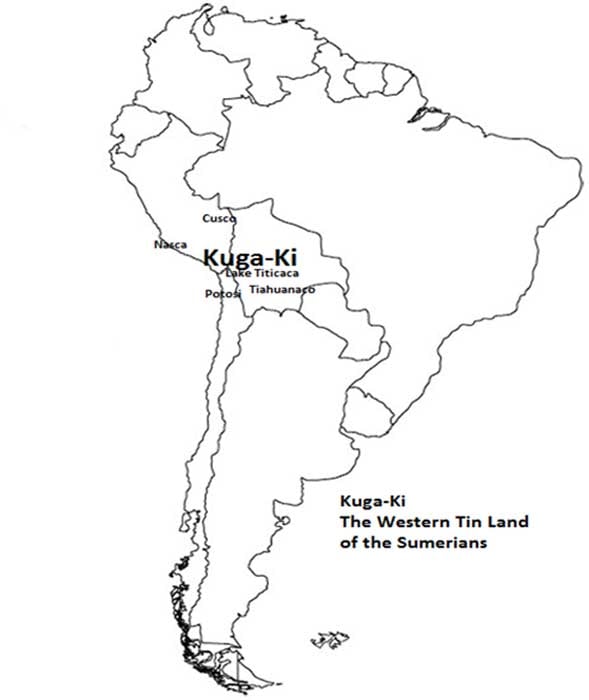
Kuga-Ki, The western Tin Land of the Sumerians (Courtesy author)
Lake Titicaca and Lake Poopo are connected by the River Desagua dero. The companion Lake of Poopo, was Lake Uru. The city of Oruro is located near Lake Uru.
Rich Mountain
The metals found near Lake Poopo include copper, tin, gold and silver. Here we find metals being extracted in the cities of Oruro and Corocoro where gold and copper were mined. The names for these cities suggest a Sumer origin. In Sumerian the name for city is uru. The suffixes –oro for the cities around Lake Poopo, is strikingly similar to uru.
It is also interesting to note that a major center in this area for mining is Potosi. Potosi is famous for its tin deposits. At Potosi we find the Potosi mountain which is made of solid tin and was called Mount Catavi.
- Did Paleoamericans Reach South America First?
- The Giant of Algeria: Iconographic Evidence of Roman Expeditions in the Sahara
- From Easter Island to Hawaii: Was there a Common Writing System used by Pacific Islanders?
The Potosi area was a major center of mining. In the 1550’s, the Spanish began to exploit the silver found at Potosi Hill. The Spanish called Potosi Hill, Cerro Rico or “Rich Mountain”. As a result of the Spanish attempt to fully exploit the riches in this area “a horrific” number of Indians died in the mines. Hugh Thompson in The White Rock: An Exploration of the Inca Heartland, vividly describes this tragedy.
Thompson says that “the mine consumed the labor-force of Bolivia’s Altiplano. If they didn’t die, they were ground down by the apology for a wage that was paid to them. Within a generation, the population of those parts of the Altiplano used for mine conscription was halved. Within another generation it had halved again. And still Potosi continued to exact its quota”.

Potosi, the first image in Europe. Pedro Cieza de León, 1553. (Public Domain)
In modern history Potosi has been a center for the mining of tin, copper, lead and silver. Located near Tihuanaca, Potosi may have been a center of Sumerian settlement in ancient times like the cities of Oruro and Corocoro. Bailey suggests that Potosi may relate to the Sumerian term Patesi, the Sumerian term for ‘priest king’.
The metals mined on the Altiplano were transported along the Pilcomyo River (or Rio de la Planta today). The Sumerians may have transported metals from Bolivia across the Atlantic to ancient Sumer. A great route for the shipment of tin from Kuga-ki was down the River Plate, eastward across the Atlantic, past the Cape of Good Hope, via the Indian Ocean to enter the Persian Gulf and Red Sea.
Symbols
In addition to affinity between the symbols found on the Pokotia monolith, Fuente Magna bowl, and Incan weaving, we also find that these symbols are identical to signs engraved on Moche bricks. A common feature of Huanca or carved Inca stones are steps cut into the rock.
Clyde Winters in Ancient Scripts in South America: The Sumerians in South America, has shown that the Inca Throne, an immaculately carved set of shallow steps, is similar to Proto-Sumerian signs. Other signs from huacas or carved stones at Rodadero Hill and the White Stone at Chuquipalta relate strikingly to the writing found on the Pokotia and Fuente Magna bowl.
In addition to Sumerian influence on South American writing systems, it is interesting to note that the Pokotia statue and Tiahuanaco monuments share similar headdresses and rib impressions along the chest area. This indicates a relationship between the builders of these monuments.

Pokotia statue, left and Tiahuanaco statue, right.
In the region where Kuga-ki probably existed in South America we have the Aymara language. Aymara terms relate to Sumerian terms. This is not surprising given the decipherment of the Pokotia statue and the Magna Fuente bowl. These documents indicate that the Sumerians had established many aspects of their religion in Bolivia.
- Buddhism in Ancient Egypt and Meroe – Beliefs Revealed Through Ancient Script
- The Elephant Slabs of Flora Vista: Enigmatic Artifacts with Ancient African Origins
- Did West Africans live in Four Corners Region of the United States from 12th Century?
The linguistic evidence supports the view that the Sumerians living in Kuga-ki were miners. The Sumerian term for copper was urudu; this term agrees with the Aymara terms for gold 'ouri' and copper 'anta, yawri'. The similarity between urudu and, yawri and ouri suggest that the Sumerians may have been the first people in the area to exploit the metals found throughout the Titicaca area and Bolivia.
The presence of Sumerian terms in the Aymara language, Sumerian place names, and Sumerian writing on the Fuente Magna bowl and Pokotia statue make it obvious that Sumerian civilization was formerly widespread in South America. This leads me to believe that Bolivia and Peru may have represented Kuga-ki, the ‘Tin Land of the West’ mentioned in the Sumerian inscriptions.
--
Top Image: The Andes mountains at Sunset (CC BY 2.0)
References
J. Bailey. ‘Sailing to Paradise’. Publisher: Simon & Schuster; First Edition first Printing edition (August 1, 1995)
April Holloway, 2015. ‘Fuente Magna, the Controversial Rosetta Stone of the Americas’. Acient-Origins.net [Onilne] Available at: http://www.ancient-origins.net/artifacts-ancient-writings/fuente-magna-controversial-rosetta-stone-americas-003660
A.H. Sayce, “Geography of Sargon of Akkad”, Ancient Egypt, 1924.
Hugh Thompson. ‘The White Rock: An Exploration of the Inca Heartland’. Publisher: Phoenix (Sept. 15 2010)
A.H Verrill and R. Verrill. ‘Americas ancient Civilizations’. New York : Putnam's Sons, 1952.
Clyde Winters. ‘Ancient Scripts in South America: The Sumerians in South America’. Publisher: CreateSpace Independent Publishing Platform (November 11, 2015) [Online] Available at: https://www.amazon.com/Ancient-Scripts-South-America-Sumerians/dp/1519257546
















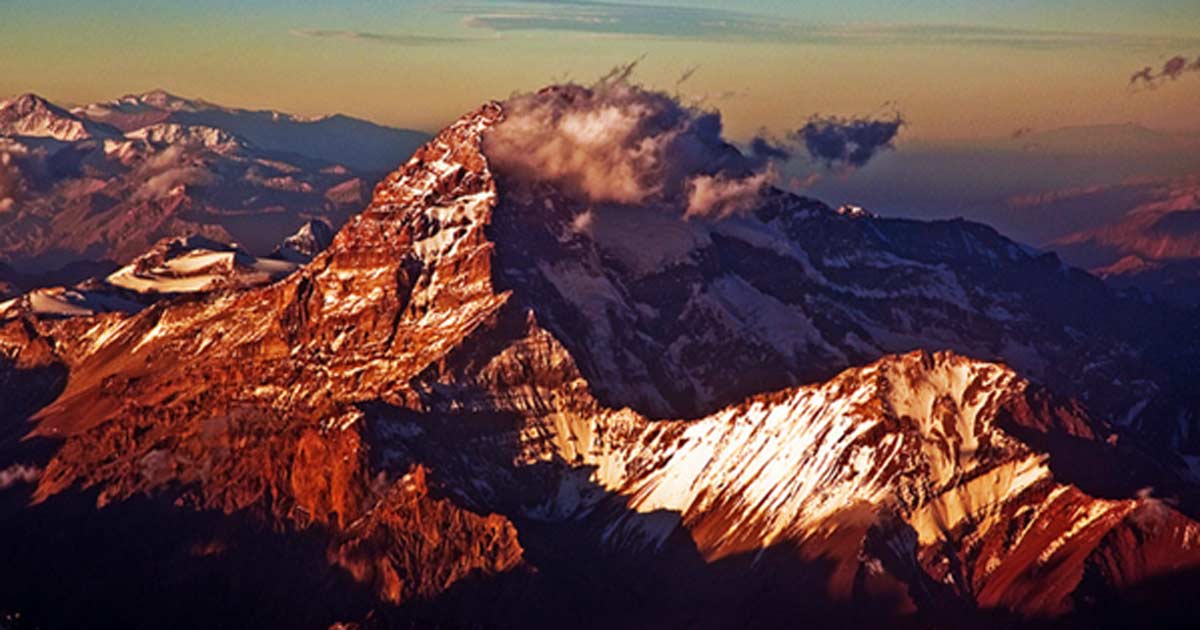

Comments
This is very possible as the Sumerians were a very dynamic people.